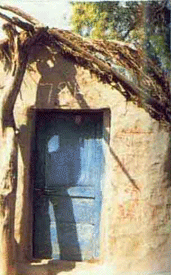The Story Of Chand Patil And Saibaba
There lived in the Aurangabad District (Nizam State) in a village called Dhoop, a well to do Mohammedan gentleman, Chand Patil. While he was making a trip to Aurangabad, he lost a mare. For two long months, he made a diligent search, but could get no trace of the lost mare. Being disappointed, he was returning from Aurangabad with the saddle on his back.
After traveling four and a half koss, he came to a mango tree, at the foot of which, sat a ratna (queer fellow). He had a cap on His head, wore a kafni (long robe) and had a “satka” (short stick) under His arm pit. He was preparing to smoke a chilim (clay pipe). Seeing Chand Patil passing by, He called out to him and asked him to have a smoke and rest a little.
The queer fellow (or fakir) asked him about the saddle. Chand Patil replied that it was for his mare which was lost. The fakir asked him to make a search in the nala close by. He obeyed and, wonder of wonders, he found the mare! Patil thought this fakir was not an ordinary man, but an avalia (a great saint) and returned to the fakir with the mare.
The chilim was ready for being smoked, but two things were missing: (1) fire to light the pipe, and (2) water to wet the chhapi (piece of cloth through which smoke is sucked). The fakir took His prong, thrust it forcibly into the ground, and out came a live coal, which He put on the pipe. Then He dashed the satka on the ground and water began to ooze. The chhapi was then wet with that water, wrung out, and wrapped around the pipe.
Thus, everything being complete, the fakir smoked the chilim and gave a smoke to Chand Patil. Seeing all that, Chand Patil was wonderstruck. He requested the fakir to come to his home and accept his hospitality. The next day, the fakir went to Chand Patil’s house and stayed there for some time. Patil was a village officer of Dhoop.
His wife’s brother’s son was to be married and the bride selected was from Shirdi, so Patil made preparations to travel to Shirdi for the marriage. The fakir accompanied the marriage party. The marriage concluded nicely and the wedding party returned to Dhoop, but the fakir alone remained in Shirdi and remained there forever.
The old house of Chandbhai Patil was demolished over a period of time and a new house was built on the same land. Here the Great Grandson Shri.Babulal Nadan Pathan (4th Generation) is residing.
The Samadhi of Chandbhai Patil is present next to the Neem Tree. It is the same Neem Tree where Sai Baba used to sit for meditation and for taking rest.
Shri.Babulal Nadan Pathan says that Shri Sai Baba stayed in this house for approximately 2 months. The Grinding Stone touched and blessed by Baba, the articles of horse "Bijlee", a painting of Saibaba with Chandbhai Patil can be seen in this ancestral house of Chandbhai Patil.
How the Fakir Got the Name Sai
When the marriage party came to Shirdi, it alighted at the foot of a banyan tree in Bhagat Mhalasapati’s field near Khandoba’s temple. The members of the party descended one by one, as well as the fakir. Bhagat Mhalasapati saw the young fakir getting down and accosted him, “Ya Sai” (Welcome Sai). Others also addressed Him as Sai and hence forth He became known as Sai Baba.
The story of Chandbhai’s mare was told by Chandbhai himself to Ramgeerbuva of Shirdi (‘Bapugeer’ as called by Saibaba). Later on, in the year 1936, Ramgeerbuva narrated it to Narasimha Swamiji, in an interview taken by the latter. At that time, Ramgeerbuva’s age was 76.
It is said that Baba appeared in the dreams of Chandbhai and found out his thoughts.












No comments:
Post a Comment